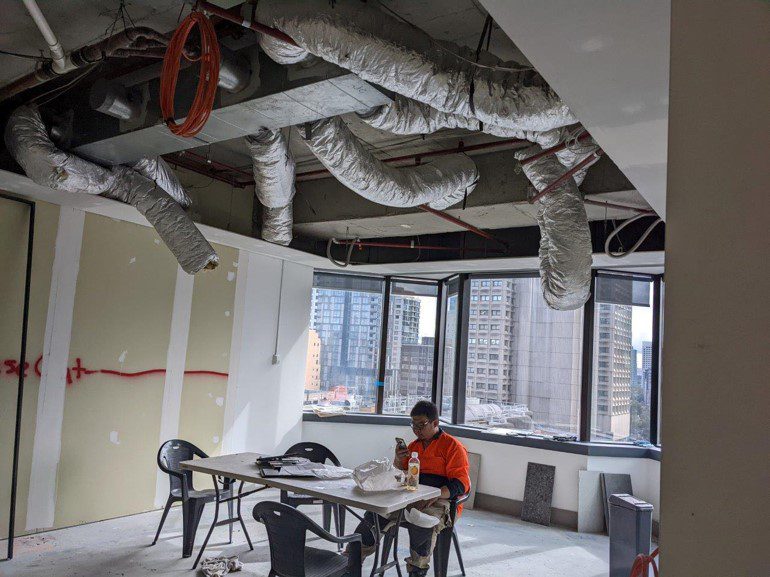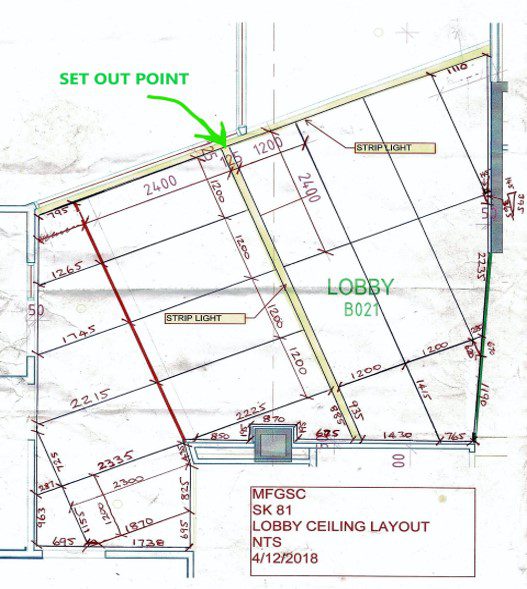This blog aims to assist installers, builders, specifiers, architects and project managers with setting out (determining the set-out points) before and during the installation of SUPACOUSTIC Timber Acoustic Panels and SUPALINE Decorative Panels.
Choosing set-out points
Correctly deciding the set-out point is a crucial aspect of installation when using SUPACOUSTIC Acoustic Wood Panels and SUPALINE Decorative Panels.
When specifying a SUPAWOOD product, all architectural timber acoustic panels and timber decorative panels have precise specification demands.
Hence, set-out points in one direction are to be determined by accounting for panel spacing and the dimensions of the installation area.
Here are some setting-out suggestions for obtaining an even joint line to all perpendicular or perimeter surfaces:
Multiple set-out points. When faced with areas with numerous set-out points, choose the most prominent door, entry or window and set your panels from the centre of that visual point. Although having multiple set-out points will result in different perimeter joint sizes, it is easy enough to calculate the range of perimeter joints - for reference with the architect.
Note: See SUPAWOOD’s recommended external corner details for the different profiles of timber acoustic panels, perforated acoustic panels, perforated acoustic panels and other decorative timber panels like SUPALINE.
Centred set-out points. Using the centreline as the set-out point of the space is recommended when you have standard-size panels that don’t have to align with anything in particular. This approach suits decorative acoustic panels, timber acoustic panels and decorative panels very well with equal or close to identical infill panels.
Single set-out point. Architects often specify a singular set-out point, which may align with a prominent item in the room. E.g. a column. The best set-out point for L-shaped rooms is generally the inside corner of the L. Note: you may have one or two surfaces with different perimeter joints. This method suits both timber acoustic panels, decorative timber panels and decorative acoustic panels.
Combination. You may have a variety of the above in one room; for example, timber acoustic panels on one side of the room may need to align with doorways, but on the other end of the room, the panels can be full-size with infills. In this case, we recommend you set out timber panels from the doorway.

Preparation is Key for Setting Out & Installation of SUPAWOOD Acoustic Wood Panels
General Recommendations for Setting Out
- Assumptions and lack of communication are the main reasons installers end up with wrong-size panels, framing in the incorrect position, or just a bad job with ugly perimeter details of the timber acoustic panels.
- Always begin with a discussion with your SUPAWOOD Project Manager. Our Project Managers can consult you about things you may have yet to consider and may stop you from making mistakes later.
- Keep open channels of communication open with the builder and architect, subject to protocols. Don’t hesitate to ask for a meeting, confirmed details, or updated drawings.
- If you need more support from a builder or contractor to communicate, ask them if they are prepared to risk the set-out.
Steps for Marking Set-out Points
- Double-check the latest architectural plan or shop drawing to ensure you have included any particular nominated set-out point.
- Double-check the final ceiling/ wall levels with the builder – these may even change from the plans to allow for services that take up more space than expected.
- Mark the set-out point on site on the floor or wall precisely where it will end up. This means you may need to allow for the thickness of packing, framing, cross battens and panels against adjoining walls, perpendicular surfaces, etc., so that the panel corner, edge and centre of the panel system will end up precisely where you have marked it.
- Ensure you have marked the set-out point so that someone can’t cover it over or erase it. If possible, make more than one mark, e.g. mark the other corners of the first panel.
Marking Remaining Panels
You have three options for marking out the remaining decorative wood panels or perforated acoustic panels, as follows:
- Set out the joint and size of the remaining panels across the rest of the ceiling or wall. You will need to work out your perimeter joints precisely to determine the size and position of your perimeter panels. This method is suitable when you have multiple alignment points, e.g. panels aligning with stairs or lift doors.
- Use standard-size panels with cut on-site infill panels. In the case of SUPACOUSTIC acoustic wood panels, if you are unsure of the position of the perimeter walls, you can determine the range of the final panel size within a tolerance of, say, 50mm. SUPAWOOD will make the border of this last panel 50mm bigger so it can be cut on-site without cutting through the slots/ holes.
- Install all decorative acoustic panels or decorative timber panels in the centre of the space. Then measure from the edge of these to the perimeter walls to determine your infill panel sizes. The disadvantage of this method is that you can only order your infill panels after you have installed nearly all the centre panels, which will not suit most builders’ programs. It is typically only used on large projects with hundreds of m2 of panels that have extended fit-out programs.
Marking remaining panels
You have three options as to how to mark out the remaining panels, as follows:
- Set out the joint and size of the remaining panels across the rest of the ceiling or wall. You will need to work out your perimeter joints precisely to determine the size and position of your perimeter panels. This method must be used when you have multiple alignment points, e.g. panels aligning with stairs or lift doors.
- Use standard size panels with cut on site infill panels. In the case of SUPACOUSTIC panels, if you are not sure of the position of the perimeter walls, you can determine the range of the final panel size within a tolerance of say, 50mm, and Supawood will make the border of this last panel 50mm bigger so that it can be cut on site without cutting through the slots/ holes.
- Install all panels in centre of the space and then measure from the edge of these to the perimeter walls to determine your infill panel sizes. The disadvantage of this method is that you can only order your infill panels after you have installed nearly all the centre panels, which will not suit most builders’ programs. It is typically only used on very large projects with hundreds of m2 of panel that have long fitout programs.
Determine Framing Position
You have two decisions to make with your framing install:
- What direction does your framing need to run; for example, will your framing run parallel with the long side or the short side of the panel? This will depend on the fixing system and if the panels are concealed fixed, so check with your SUPAWOOD Project Manager which direction the framing must run before framing.
- What centres does your framing need to be installed? Generally, this is at a maximum of 600mm centres, with framing members positioned at the two edges and the centre of the panel. However, in some cases, the framing may need to be at a maximum of 450mm centres, so check with your SUPAWOOD Project Manager.
- Plan special framing arrangements. Plan where you may need to do special framing, for example, long spans underneath services, prefabricated shaped or curved framing sections, or bulkheads you will need to build. Some situations may require special panel modifications, so review these with your SUPAWOOD Project Manager.

Panel set-out points
We would love to help you with your next project. If you have a challenge right now that you would like us to help you with, please contact SUPAWOOD here.
Disclaimer: All the information on this website - www.supawood.com.au - is published in good faith and for general information purpose only. Supawood does not make any warranties about the completeness, reliability, and accuracy of this information. Any action you take upon the information you find on this website (Supawood), is strictly at your own risk. Supawood will not be liable for any losses and/or damages in connection with the use of our website.
From our website, you can visit other websites by following hyperlinks to such external sites. While we strive to provide only quality links to useful and ethical websites, we have no control over the content and nature of these sites. These links to other websites do not imply a recommendation for all the content found on these sites. Site owners and content may change without notice and may occur before we have the opportunity to remove a link that may have failed.
Consent: By using our website, you hereby consent to our disclaimer and agree to its terms.
